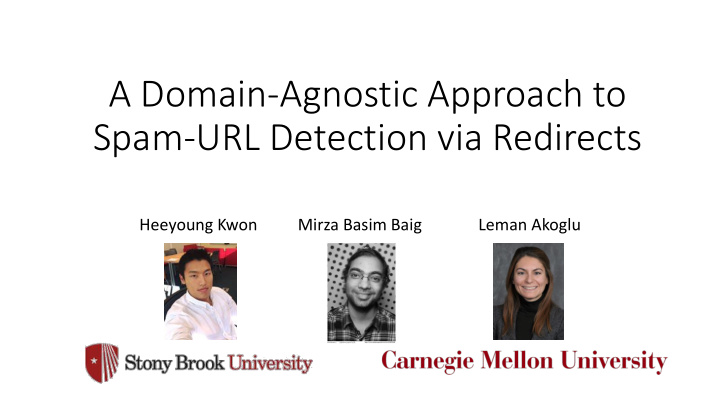



A Domain-Agnostic Approach to Spam-URL Detection via Redirects Heeyoung Kwon Mirza Basim Baig Leman Akoglu
Era of Spam
Era of Spams [1] [1] Social Media Spamming Grew By 658% Between 2013 And 2014: Entertainment, Financial And News Categories Main Target, https://dazeinfo.com/2014/12/15/social-media-spamming-growth-2014-facebook-twitter-entertainment/
Popular Solutions • IP blacklisting • Popular for social media and URL shortening services • False negative rates between 40.2 to 98.1% • Slow and unscalable • Account based approach • Limited ability to detect compromised accounts • Require a history of malicious behavior • Not generalizable to different services
Popular Solutions • IP blacklisting • Popular for social media and URL shortening service • False negative rates between 40.2 to 98.1% URL-level decisions are required • Slow and unscalable - able to filter individual post - more generalizable • Account based approach • Limited ability to detect compromised accounts • Require a history of malicious behavior
Domain-Agnostic Approach • Leverages widespread of redirect chains by spammers • Extracts robust features to capture the nature of spammers’ behavior • Can be applied into different domains
Redirect Chain
Redirect Chain • Initial Pages - URL displayed to users • Landing Pages - Where the user ends up
Redirect Chain Graph • Identify same URLs • Aggregate chains • Find Entry points • Largest in-weight node in each chain
Feature Design • Three groups of Features that characterize spammers’ behavior • Shared resources • Heterogeneity • Flexibility
Features – Shared Resources • To reduce costs, sharing resources is inevitable • Reuse of URLs • Same servers hosting many different domain names. Shared URLs • To evade and stay ahead of domain blacklisting • Total 17 features
Features – Heterogeneity • “Don't put all your eggs in one basket” • Place servers to different geo-locations • Use of compromised servers and bot machines Geo Loc1 Geo Loc2 Geo Loc3 • Total 12 features ghi.com abc.com def.com
Features – Flexibility • Two types of flexibility: • For luring more users • Multiple different initial URLs • For evading detection • Using multiple landing URLs with redundant content • Same URLs with different IPs • Dynamicity and selectivity using long redirect chains • Total 10 features
Dataset • Tweets • 3,764,395 tweets have URLs • 3,871,911 initial URLs are identified • Redirect Chain • Chain lengths are vary from 1 to 46 • 99% of chains are less than length 6 • Redirect Chain Graph • 4,874,256 nodes • 3,839,633 edges
Experiment • Supervised Detection • Compare between context-free and context-aware detection • Semi-supervised Detection • Small fraction of labels are revealed (1% or 5%) • Loopy belief propagation (LBP) through user-URL bipartite graph
Result – Supervised methods • Context-free features achieve competitive performance
Result – Feature importance score • Top features evenly come from all three categories
Result – Semi-supervised methods • Red dots show the performance at threshold 0.5
Conclusion • Alternative approach to detect spam URL using Redirect Chain Graph • Context-free • Adversarially robust • Semi-supervised data available at: http://cs.stonybrook.edu/~heekwon
Thank you!
Recommend
More recommend